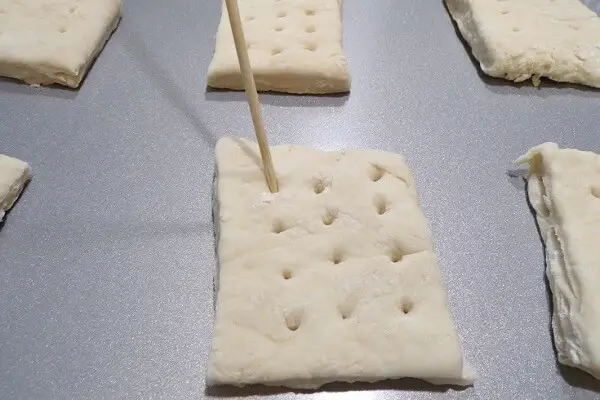Created by Media Library Corporation for the purpose of learning a higher understanding of life creation.
Thursday, August 2, 2018
Tuesday, July 31, 2018
Survival food How to Make Hardtack
 Hardtack is a survival food that can sit on the shelves for years. It was first made popular during the Civil War when soldiers were given rations to take into the field. With no refrigeration or luxuries like sugar available, they were forced to survive on the very basic, bland, and incredibly hard crackers that were fondly dubbed hardtack.
Hardtack is a survival food that can sit on the shelves for years. It was first made popular during the Civil War when soldiers were given rations to take into the field. With no refrigeration or luxuries like sugar available, they were forced to survive on the very basic, bland, and incredibly hard crackers that were fondly dubbed hardtack.
It isn’t something you would probably want to make and serve to guests today, but you need to know how to make it, just in case. You can make hardtack now and seal it up tight to help fatten your food storage. In an actual survival situation, you could make the hardtack over a fire or in a Dutch oven. It is very easy to make, even if it isn’t exactly the best-tasting food.
Check out the 5 easy steps to making hardtack.
What you will need:
- 5 to 6 cups flour
- 1 cup water
- Rolling pin
- Pizza cutter or knife
- Cookie sheet
- Skewer (a fork could work in a pinch)
Step 1: Preheat your oven to 375 degrees Fahrenheit. Pour the cup of water into a bowl. Slowly mix in the flour until it makes a hard dough you can’t stir. When it gets to this thick stage, it is easiest to knead the dough with your hands to form a ball of dough.

Step 2: Lightly flour your surface and place your dough in the middle. Use the rolling pin to roll out the dough into a rectangle about half an inch thick.

Step 3: Use the pizza cutter to cut your dough into squares. The size of a saltine is a good size to aim for.

Step 4: Transfer the squares onto an ungreased cookie sheet. Use the skewer or a fork to poke holes through the entire thickness of each square. You can make rows of four or cover the area with holes as you please. It doesn’t have to be pretty, but the goal of the holes is to allow the dough to cook thoroughly.

Step 5: Place the hardtack into the oven and cook for 30 minutes. Remove from oven and use a spatula to flip the hardtack to the other side. Cook for an additional 30 minutes. Remove from oven and allow to cool.

If you are storing your hardtack, it needs to be completely cool before you seal it up. The dough needs to be cooked thoroughly and dried out. Even a little moisture can spoil the hardtack. For long-term storage, it is best to cook the hardtack for an additional 30 minutes at a temperature of 250 degrees. Yes, it is going to be rock-hard, which is why it earned the name.
You can add a little salt to the dough for flavor. Topping the hardtack with raw honey or fruit preserves adds a little more flavor, making it more palatable. Hardtack can be dipped in stews or soups to help thicken them up and turn them into a more filling meal
How To Vanish Off The Grid, And Live The Stealth Life
If you’ve ever wanted to really vanish off the grid and live the stealth life, or just protect your privacy this amazing video will show you how to get started. What would it take to wipe the slate clean and live a life free of big brother and siste
He is an author, inventor, environmental & social activist, design scientist, television & radio commentator & the current Executive Director of the International Preparedness Network (I.P.N.)
Here are some of the highlights from the video below:
- There are 30 million plus surveillance cameras on the US, one camera for every ten americans.
- The average American is in 200 databases.
- Putting a plan in motion to keep you from being tracked is a good idea if you want to devise a new life for yourself
- Plan 3 months ahead of time
- Right before you leave, change your appearance significantly (if you have hair, shave your head, if you have blond hair, change it to black, get glasses, etc.).
- Before you leave, terminate all of your accounts (email, bank accounts, credit cards, etc).
- Don’t terminate your social network sites as you can use these sites to provide disinformation.
- Before you leave, delete all of your computer files and get rid of your computer’s hard drive (first boil the hard drive then smash it with a hammer and finally run a Degausser/electromagnetic wand over the drive to obliterate all information it may contain).
- Get rid of all of your personal items like photos, trophies, mementos, etc. that could tie you to your old life.
- Shred all of your personal info and credit cards/bank statements/etc., next take the shredded material and spread it around in a bunch of trash bags and leave the bags at various dumpsters around the city, or burn it.
- Get rid of your cell phone as these can be easily used to track your location either through a computer software program or through triangulation.
- Wipe all of your info from your cell phone then leave it at a train or bus station so that someone else will pick it up and start using it, thus providing a source of disinformation for those searching for you.
- Break your normal patterns (what you eat, where you frequent, how you shop, the kind of work you do, etc).
- Ditch your car and find a substitute that is not your personality.
- Completely change your lifestyle (ie: if you are currently a corporate lawyer, become a night janitor then dress and behave appropriately).
- If you do take your car get rid of the toll pass which can track your movements through the RFID chip in the pass.
- Stay away from interstate highways.
- Get rid of the GPS device which came with your car. Ditto for the OnStar system which can be activated remotely and allow others to listen in on your conversations.
- Make sure your tires don’t have RFID chips in them. Some tires have these chips and they can link to your VIN number and the purchase location of the tires.
- Go to non-chain restaurants.
- Pay for everything with cash.
- When you are out in public disguise yourself (at least wear a hat and sunglasses).
- Avoid frequenting your usual places (for example, if you are a vegetarian your meal preference can be found through your prior airline meal request and then you may be easier to locate if you frequent vegetarian restaurants).
- Get your food to go from restaurants so you don’t leave DNA on the plates/utensils/glasses which can be read with an easily purchased BPac machine which analyzes your biometrics.
- Stay in small motels and pay with cash.
- Use alcohol wipes to remove fingerprints.
- Use a Multi Sweep Hidden Camera & Bug Detector
to check for hidden bugs/cameras/etc.
- Cover the peephole so people can’t see into your room.
- Sleep in your sleeping bag so you won’t leave DNA behind on the hotel bedding.
- Buy a pre-paid cell phone which you only use for outgoing calls (be sure to turn off the caller ID). Replace the pre-paid phone frequently, about every 2 weeks.
- When you are not using the cell phone, remove the battery so it can’t be turned on remotely or used to track you.
- Be careful when speaking in cars or near windows. The NSA has a bounce laser monitoring system which can pick up sound waves on glass and record what you are saying.
- At night you can avoid being seen on cameras that use infrared light by fashioning a cap with LED lights on the front of it which makes a “halo” and shields your face from the cameras.
- To determine the best place to resettle, choose a mid-sized city in a not overly cold place. Big cities and small towns are not good places for anonymity.
- To change your identity don’t just assume the identity of someone else (this is way more difficult–and illegal–than it used to be), instead petition the court to change your name legally to a new–and common–name.
- Apply for a driver’s license under your new name.
- Most driver’s licenses and passports have RFID chips in them. Block people from reading these RFID chips by carrying them in a wallet lined with aluminum foil.
- To get back online, use a new laptop.
- Always use a hard wire to your laptop and turn off the wi-fi which is easily hacked.
- Put a cover over your web cam such as a band-aid or electrical tape as these can be turned on remotely like your cell phone.
- Install anti-key logger software on your computer.
- Also, install software that will reroute your ip address so your location can’t be determined via your computer.
- Be aware of the ECHELON program in the US which monitors phone and computer transmissions for keywords and messages.
- At the grocery store, change your shopping habits and never use store club cards.
- Be aware that nearly all food packaging now contain RFID tags. To be sure these aren’t used for tracking (unlikely now but possibly more likely in the future) repackage food once you purchase it and get rid of the store packaging.
- To find work, get a night job that is different that your previous job, such as a janitor. This will limit your contact with people.
- Change jobs often.
- Create a “back story” for your new identity and practice it. If you base your lies on the truth but change the details a bit, your story will be easier to remember and more believable.
- Open a bank account, preferably at a small, local bank.
- Be aware of video surveillance cameras which are everywhere.
- Never contact people from your past.
- The narrator noted that every year, changing your identity gets harder.
- The police now consider common activities suspicious such as bird watching, sketching or painting, or taking photographs in public.
- There are 70 FUSION centers in the US which coordinate surveillance and other information.
- Airlines sometimes use locator chips on your bags so be aware of this. You can also use these tagged bags for disinformation purposes (ie: leaving them in places to throw people off your trail).
- Technology is now available to identify you by the way you walk (change the way you walk), your facial measurements and biometrics (use a disguise, and especially sunglasses), and even your response to images.
- It will be 7 to 10 years before your old identity drops off of old databases.
- Guard against complacency.
- The less you interface with technology, the better off you will be. Source: BeSurvival.com
Media libraries Survival Tools And Tricks issue 1
Some of these tools, and tricks are quite different, and we’re pretty sure you haven’t seen most of them before. Here are 10 weird survival tools, and tricks you probably haven’t seen before. Some of them are quite different.
1-Condoms
Condom-Sling-Shot-In-Use
It’s an old adage: if you have enough condoms, you can survive in the wild for years. And even if we just made that up, it’s still true. Condoms can provide you with food, water, fire, and shelter—the four key elements of survival.
Getting stranded with a condom shipment would be the luckiest break apart from not getting stranded at all. For starters, condoms make very decent water storage containers. You would be surprised at how big they can get—two or three full condoms will provide enough water for a person for a week.
Condoms also burn. A latex condom will light up instantly, making it perfect tinder for getting a fire going. And since they’re watertight by nature, they can also be used to safely carry dry tinder.
In a pinch, you can use condoms as rope to tie up a tarpaulin for shelter or—seriously—even turn them into a slingshot to hunt small game. Yes, you can hunt wild animals with condoms.
2-Bubble Wrap
f you’re suffering from hypothermia, bubble wrap can save your life. Who would have guessed? Apparently, the air bubbles in the packing material create an insulating shield that bounces back body heat to keep a person warm.
In one study, it was found that a sheet of bubble wrap was about seventy percent as effective as three cotton blankets for insulating a person—and since it’s made out of plastic, it was even more effective in the wind and rain.
So if you’re ever caught in a snowstorm with nowhere to go, reach for the bubble wrap—just try to resist the impulse to pop the bubbles if you get bored waiting to be rescued.
3-Saran Wrap
This is honestly something you should never attempt, and hopefully you’re never in a situation that would call for you to perform first aid on a lung puncture—but hey, knowledge is power.
A sucking chest wound is a type of wound that penetrates through the chest wall and into the lung. Because of the extra lung hole, air can escape through the chest with a distinctive “sucking” sound (hence the name).
Needless to say, sucking chest wounds are usually fatal unless they’re treated immediately—and when you’re thousands of miles from the nearest hospital, you’d think that would be bad news.
But here’s what you can do: find a piece of plastic (saran wrap is perfect) with which you can seal the hole, so that the chest cavity around the lung doesn’t get more air pressure than the lung itself.
If this happens, the lung will collapse. When you seal the hole, leave a flap at the bottom that will allow air to leave through the wound without entering it. This may seem useless now, but you never know—you might have to save someone’s life someday.
4-Dakota Fire Hole
By this point you should be pretty confident that you have what it takes to survive in the wild—so let’s up the stakes. You’re not just trapped out in the wilderness, now; you’re behind enemy lines, and you have to survive without letting the enemy know where you are. Obviously a fire is out of the question—or is it? A Dakota fire hole might be just what you need.
It’s basically two pits dug side-by-side in the ground with a tunnel connecting them. The fire is in one pit, and the other pit allows air—and oxygen—to reach the fire from below via the tunnel. From a practical standpoint, this is also an ideal way to keep a fire going in very windy conditions—but you can still pretend you’re hiding out from murderous cannibals, if you want.
Here at media library we redesigned this pod shelter to do a few more things than it was invented to do
The Duckweed Survival House is a floating emergency shelter designed to elevate survival rates and assist with rescues in disaster situations such as tsunamis and floods. An alternative to exposed life rafts, the enclosed design providers shelter from the elements and even large waves that have potential to overthrow or exhaust survivors. The weight underneath ensures the unit won’t tip over and is stabilizing in rough waters. We also designed it to have a small built-in turbines for electricity, enough to power lights and clean water. We are also designing it to fit into a backpack or a life jacket, just put it on during the emergency and inflated near or in the water.
Original Designer: Zhou Ying, Niu Yuntao
The specifics of wilderness survival change a lot depending on what part of the world you’re trapped in. Knowing how to treat hypothermia is about as useful as a bag of malaria for a castaway in the tropics, but it’s the difference between life and death when you get locked in the meat cooler at work again. But one constant in nature is that you can almost always find a body of water—and if you have the know-how, this water means food.
So what if you don’t know how to fish, or don’t have any gear? All you need is a shirt and enough saliva to spit. Spit fishing is a quick way to catch minnows and small fish, which can then either be cooked up into a crunchy goulash or used as bait to catch bigger fish. All you do is wade out into the water, lift the front of your shirt to improvise a net under the water’s surface, and spit. Minnows are attracted to the spit—they think it’s food—and when they’re clustered in front of you, jerk your shirt up out of the water.
Tampon Fishing Bobber
Tampons are almost as useful for surviving in the wild as condoms—and as weird as that sounds, it’s not even a little bit sarcastic. A tampon has four basic parts: a plastic tube, cotton wadding, string, and an airtight wrapper. For a quick DIY fishing bobber, open the wrapper at one end, take the tampon out, then tie the wrapper closed with a bubble of air inside.
If it doesn’t float, stuff some of the cotton into the bubble. Now you can tie your bobber to a fishing line and leave it while you take care of more important things, like scaring all those bears away from your campsite. It’s all about multitasking.
But that’s not all you can do with a tampon. The cotton makes perfect tinder for starting a fire. Stuff the cotton into the plastic tube to make a filter straw for drinking sediment-heavy water. Use the string to tie a puff of cotton to the end of a wooden skewer—and now you have a dart for your blowgun. At the very least, the absorbent cotton makes an effective bandage for cuts and scrapes. Perhaps you should make room for tampons in your survival kit.
Subscribe to:
Posts (Atom)
-
Medialibraryinfo@gmail.com +1-313-651-5349 Media Library Text 313-777-3031 Let's talk about another invention that here in the US tri...
-
Medialibraryinfo@gmail.com +1-313-651-5349 Media Library Text 313-777-3031 now if you apply this waste oil burner to the concept you j...
-
Here's an update from this blog post : This picture has been removed many times from this site why? It is the purpose why we a...
-
Medialibraryinfo@gmail.com +1-313-651-5349 Media Library Text 313-777-3031 Stop hiding free energy For yea...
-
Medialibraryinfo@gmail.com +1-313-651-5349 Media Library Text 313-777-3031 Here is an update to the fiber-optic solar batteries, the batte...
-
Medialibraryinfo@gmail.com +1-313-651-5349 Media Library Text 313-777-3031 Hope to update this paper soon very interesting article growing...
-
Please forgive us if you do not speak Spanish you must remember the u.s. is not the only one with ideas and Technology. We will try and giv...
-
Medialibraryinfo@gmail.com +1-313-651-5349 Media Library Text 313-777-3031 Let's use some low technology to build a face mask what did...
-
Medialibraryinfo@gmail.com +1-313-651-5349 Media Library Text 313-777-3031 If you are conscious then this video is a how-to if you ...
-
Medialibraryinfo@gmail.com +1-313-651-5349 Media Library Text 313-777-3031 There's a new type of Technology oh, that actually is quite...









